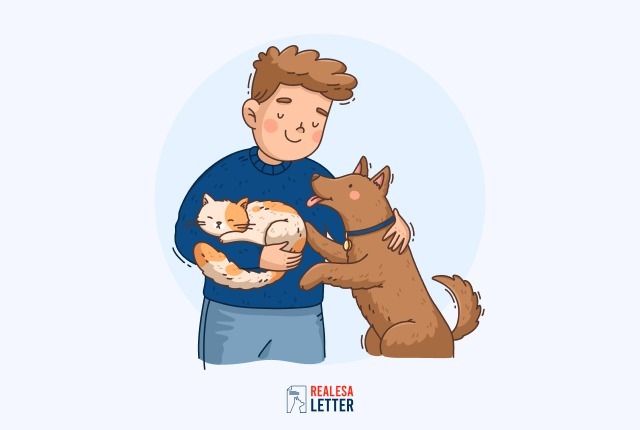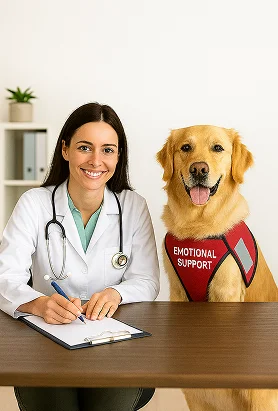Many U.S. veterans struggle with mental health challenges like post-traumatic stress disorder or insomnia, which make daily life feel extremely difficult.
Without proper support, these invisible wounds can lead to isolation, disrupted sleep, and deepening anxiety, undermining confidence and connection.
Greet emotional support animals! Compassionate companions that don’t require extensive training programs like guide dogs or psychiatric service dogs, yet still offer profound comfort and relief.
In this guide, we'll walk through how ESAs empower veterans, what benefits they bring, and how to obtain one in the U.S., complying with emotional support animal laws.
What are the Emotional Support Animals for Veterans
Emotional Support Animals (ESAs) are companion animals (often dogs) that provide comfort and emotional relief to veterans facing mental health struggles.
Unlike service animals trained to perform specific tasks (e.g., trained service dogs or mobility service dogs), ESAs don’t require certified training programs, yet they play a vital role in improving the lives of veterans.
Best ESAs for Veterans:
- Labrador Retriever – affectionate, intuitive, and calm, ideal for providing comfort.
- Golden Retriever – gentle temperament and strong emotional connection.
- Poodle or Poodle Mix – low-shedding, versatile, and empathetic.
- French Bulldog – small, affectionate, and well-suited for apartment living.
- Corgi – friendly, alert, and excellent at reducing feelings of loneliness.
- Mixed Breed Companion – loyal, adaptable, and often overlooked heroes.
Emotional Support Dog for Veterans with PTSD
An emotional support dog for vets with PTSD can bring significant, daily comfort. These dogs act as warm, empathetic buddies, helping to ease symptoms of anxiety, calm emotional turbulence, and reduce the impact of flashback episodes.
While not formally trained like psychiatric service dogs, their presence, aided by deep emotional bonds, can be a powerful calming factor for veterans battling post-traumatic stress.
What Can an Emotional Support Animal Do: A List of Benefits for Veterans
Let’s explore how an ESA can make a real difference:
- Reduced Anxiety & Depression: ESAs offer companionship and gentle presence that soothe mental distress and help veterans feel more grounded.
- Lowered Stress Levels: Petting or interacting with an ESA triggers stress-relieving neurochemicals like oxytocin, bringing calm during emotionally draining moments.
- Nightmare Interruption & Better Sleep: ESAs can nudge or physically comfort veterans during nightmares, helping interrupt distressing sleep cycles and promoting rest.
- Improved Social Interaction & Physical Activity: Walking or caring for an ESA invites gentle social interaction and encourages movement, thus uplifting both mood and physical wellness.
- Minor Feelings of Loneliness & Social Isolation: A consistent, affectionate presence helps combat isolation, especially for veterans who may feel disconnected from friends or family.
- Increased Sense of Purpose: Caring for an animal fosters daily routine and responsibility, helping veterans reclaim a sense of meaning and structure.
- Calmness and Clear Focus: The presence of an ESA can reduce mental clutter, offering a centering influence that aids concentration and emotional regulation.
- Tactile Stimulation: Touching, like simply stroking or snuggling the animal, provides comforting sensory input that eases stress and brings warmth.
How to Get An Emotional Support Animal for Veterans: Eligibility Cases Defined
Mentioned are the scenarios where a veteran would get an ESA for their well-being:
Case #1: A Veteran Facing Insomnia
If sleeplessness is due to anxiety or trauma, an ESA that comforts or gently wakes the veteran during distressing nights can alleviate sleep disruptions and provide a soothing presence.
Case #2: A Veteran Experiencing PTSD & Flashback Episodes
Veterans living with post-traumatic stress disorder may face sudden, intense flashbacks. An ESA’s calming presence can offer emotional grounding, helping in moments when the world feels unsafe.
Case #3: A Veteran Capable of Everyday Activities Yet Isolated from Loved Ones
Even veterans who manage daily tasks may suffer from emotional isolation. An ESA offers companionship, purpose, and a connection that bridges gaps left by distance or emotional withdrawal.
How to Obtain an ESA as a Veteran in the U.S.
Here’s a streamlined process veterans can follow to gain access to an Emotional Support Animal in the U.S.
Step #1: You Must Be Diagnosed with a Mental Health Disability
First, ensure you have a formal diagnosis, such as anxiety, insomnia, or post-traumatic stress disorder, from a qualified healthcare provider. This diagnosis is essential to support your need for an ESA.
Step #2: Consult with a Licensed Mental Health Professional
Reach out to a licensed mental health professional (LMHP) like a psychologist, psychiatrist, or therapist, who understands how ESAs can support emotional well-being and daily functioning.
Step #3: Request an Emotional Support Animal Letter for Veterans from Your Therapist
Ask your provider for an official ESA letter. This is sometimes referred to as emotional support animal registration for veterans, affirming that an assistance animal is part of your therapeutic plan.
This documentation can make housing accommodations and travel easier under federal protections.
Once you have your ESA letter, keeping it updated with an ESA letter renewal can make the housing process smoother, since many landlords prefer up-to-date paperwork.
For reference, you can review this sample ESA letter to get a better idea of the information typically included.
Step #4: Select the Right Animal for Your Emotional Support Needs
Choose an animal, whether dogs for veterans, cats, or other suitable pets, that fits your living situation and emotional requirements. Consider traits like temperament, size, and energy level to determine the best match.
Step #5: Provide the Best Care for Your ESA
Once your ESA is with you, prioritize their well-being. Schedule regular vet visits, offer proper nutrition, and engage in affectionate bonding. Caring for your ESA supports their health and your emotional partnership.
Summing Up,
Emotional support animals serve as compassionate lifelines for many veterans. While they differ from service animals or trained service dogs that perform specific tasks, ESAs bring emotional support, stability, and tactile comfort that can transform the lives of veterans.
By following the simple steps mentioned, vets can access this helpful resource. If you're seeking real relief and a loyal partner in your healing journey, consider trying RealESALetter for a legitimate ESA letter that recognizes your needs and supports your path to well-being.
Pricing
PSD Letter
Reviews
ESA By States
ESA Laws
Resources




